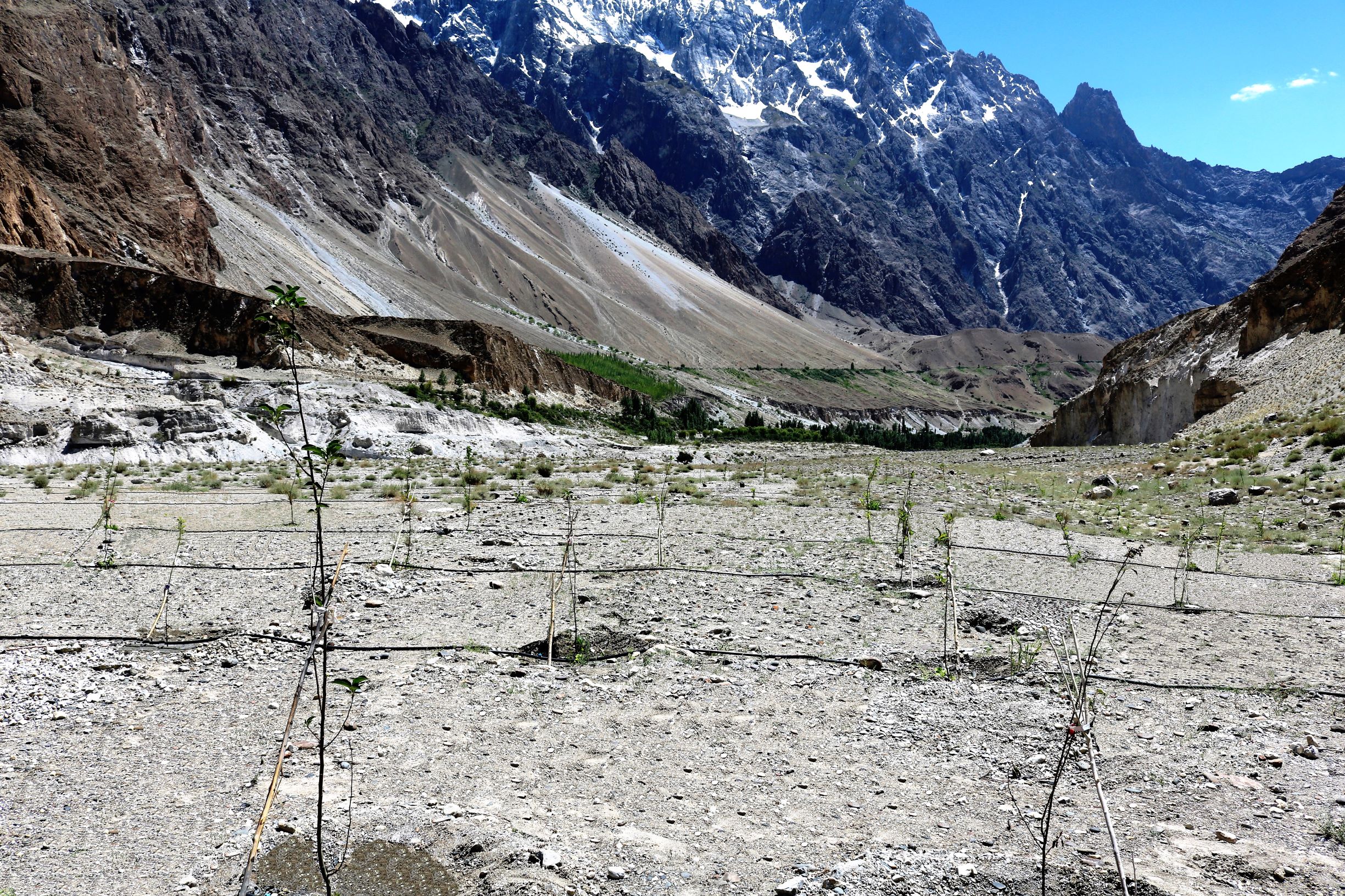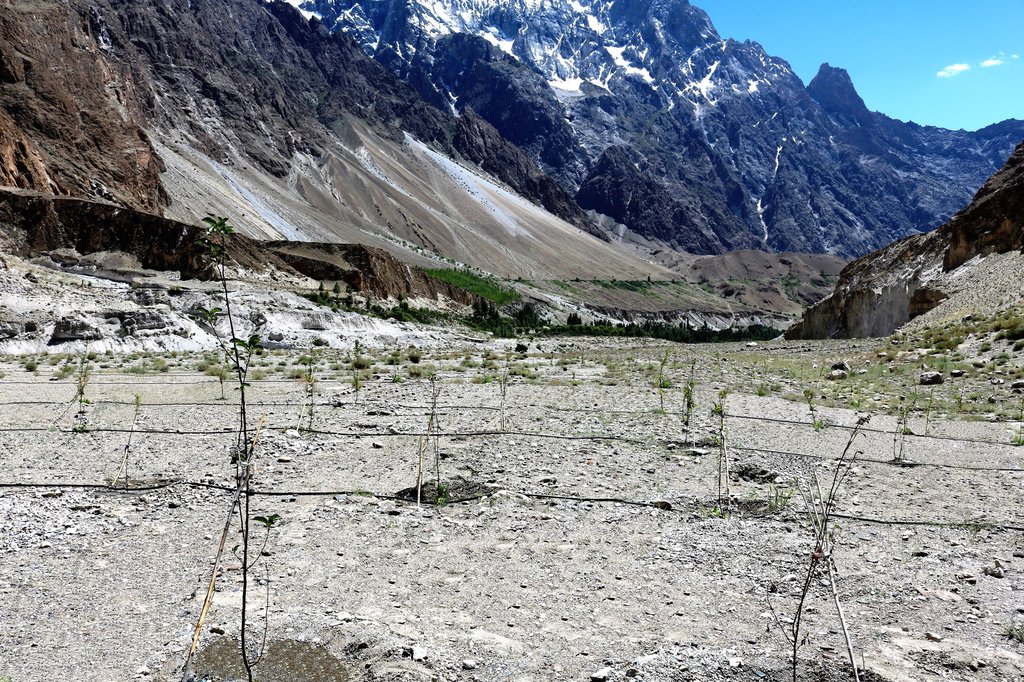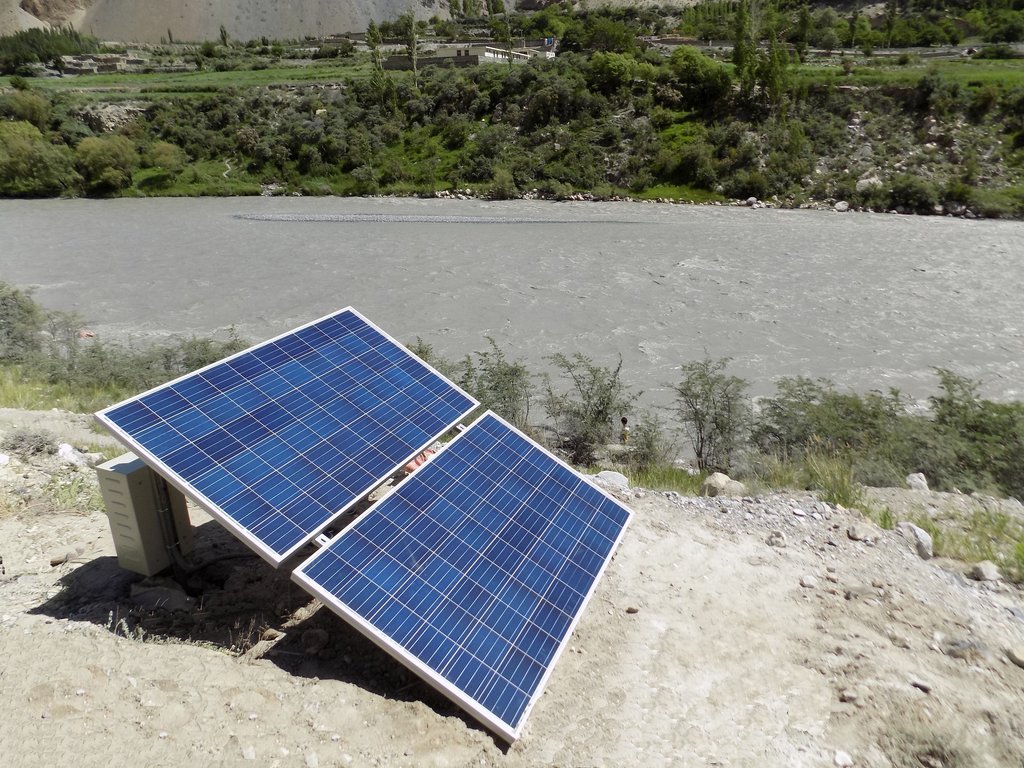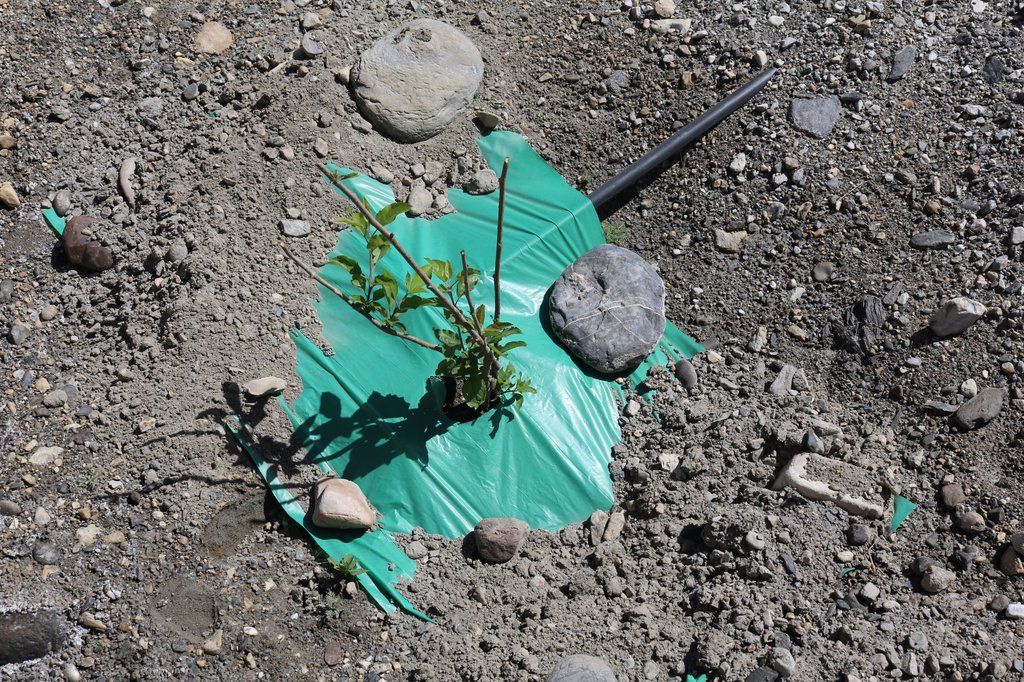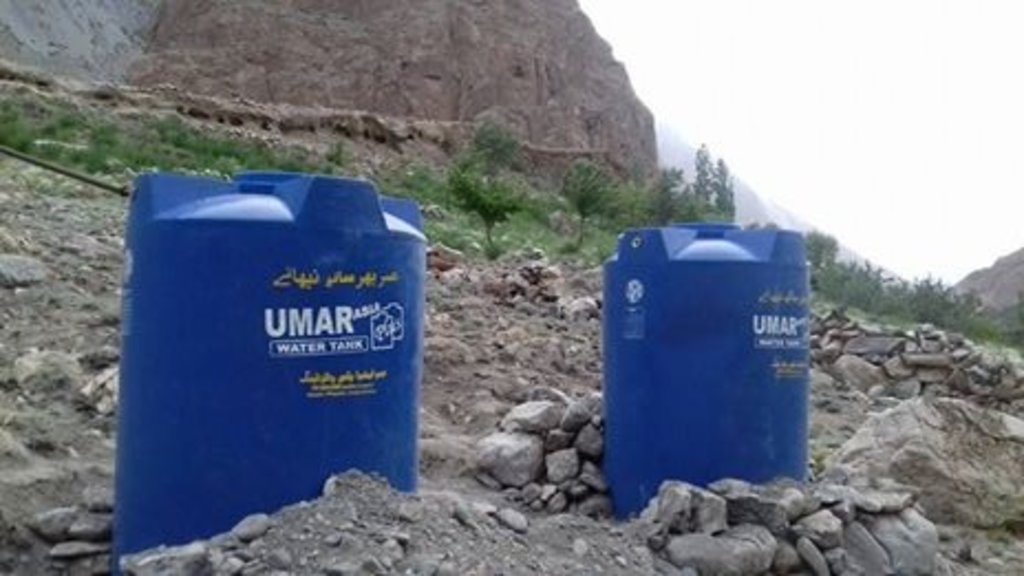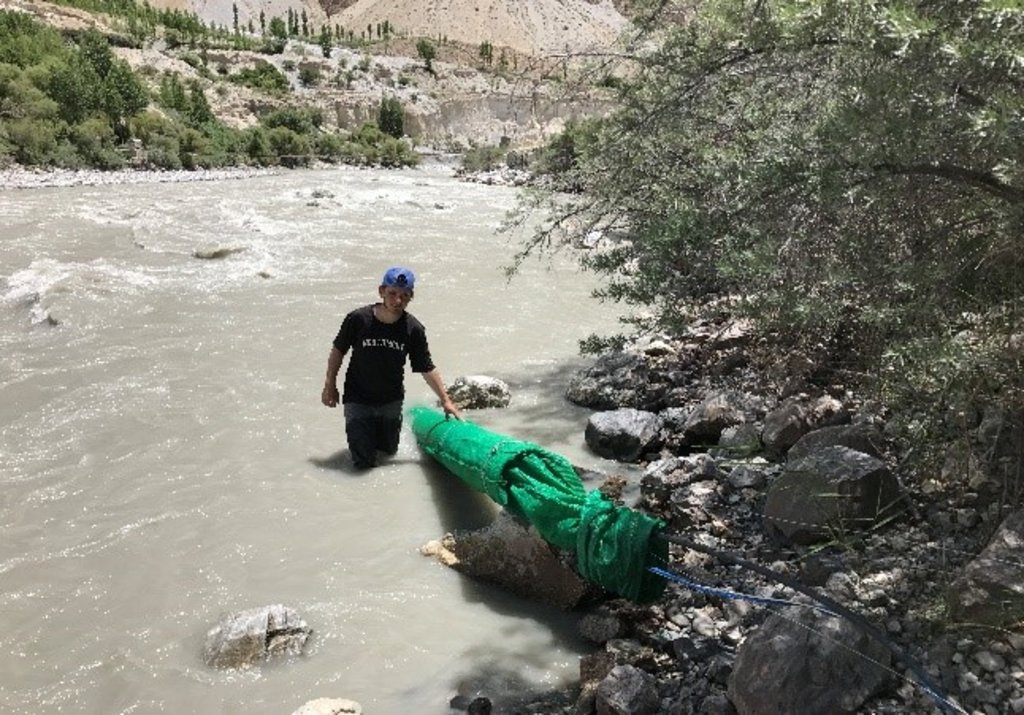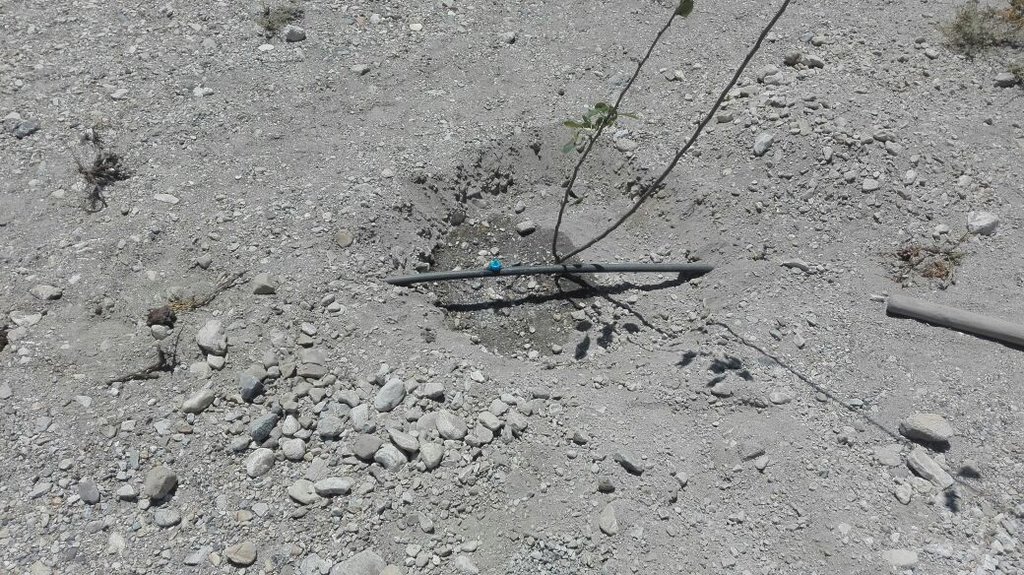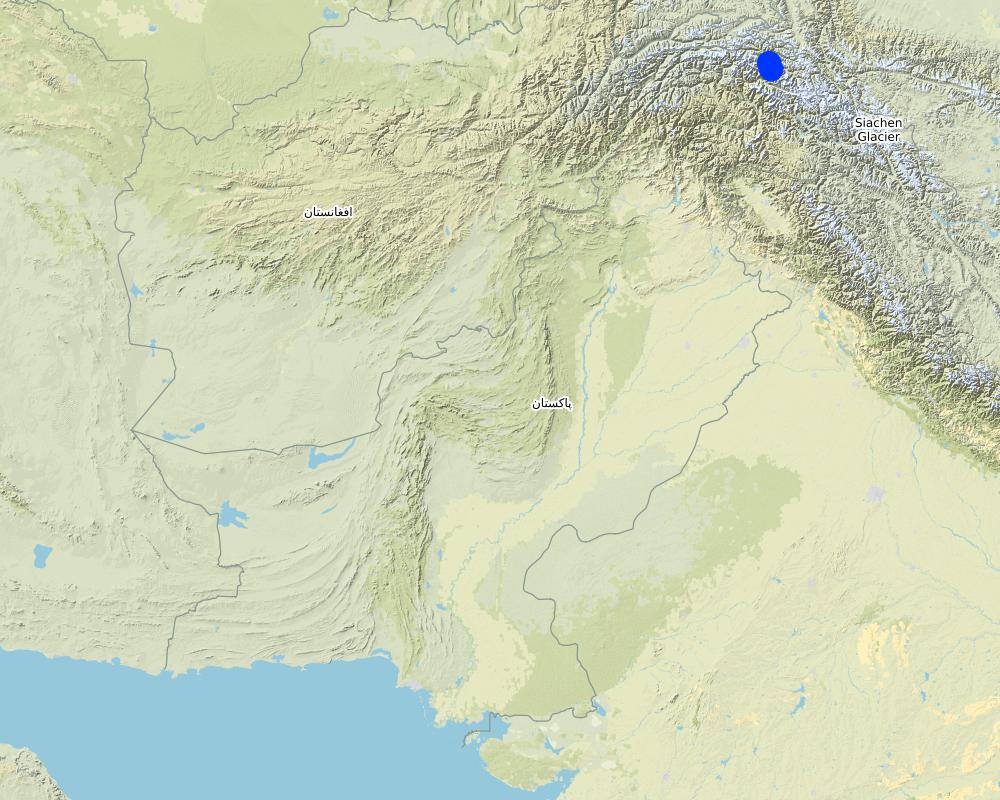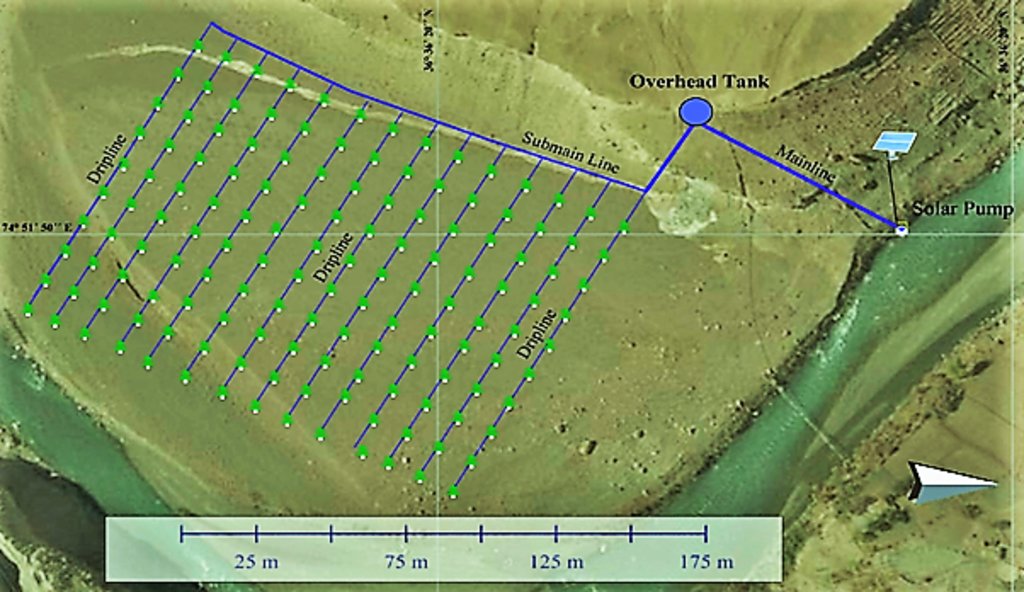Solar Power Water Lifting and Application to Orchard through Drip Irrigation [Paquistão]
- Criação:
- Atualização:
- Compilador/a: Madhav Dhakal
- Editor: –
- Revisor: Rima Mekdaschi Studer
technologies_5610 - Paquistão
Veja as seções
Expandir tudo Recolher tudo1. Informação geral
1.2 Detalhes do contato das pessoas capacitadas e instituições envolvidas na avaliação e documentação da tecnologia
Pessoa(s) capacitada(s)
Especialista em GST:
Maqsood Muhammad Mudassar
International Centre for Integrated Mountain Development
Paquistão
Especialista em GST:
Shah Ghulam Muhammad
International Centre for Integrated Mountain Development
Paquistão
Especialista em GST:
Bhatti Ahmad Zeeshan
Pakistan Council of Research in Water Resources
Paquistão
Especialista em GST:
Khan Muhammad Zafar
Karakorum International University
Paquistão
Especialista em GST:
Khan Babar
World Wide Fund For Nature
Paquistão
Especialista em GST:
Ali Rehmat
World Wide Fund For Nature
Paquistão
Especialista em GST:
Ali Amjad
Karakorum International University
Paquistão
Especialista em GST:
Ali Ajaz
International Centre for Integrated Mountain Development
Paquistão
Especialista em GST:
Dhakal Madhav
International Centre for Integrated Mountain Development
Nepal
Nome do projeto que facilitou a documentação/avaliação da Tecnologia (se relevante)
Agricultural Water, Energy, and Hazard Management for Improved Livelihood in the Upper Indus Basin, Pakistan (UIB, Pakistan)Nome da(s) instituição(ões) que facilitou(ram) a documentação/ avaliação da Tecnologia (se relevante)
ICIMOD International Centre for Integrated Mountain Development (ICIMOD) - Nepal1.3 Condições em relação ao uso da informação documentada através de WOCAT
O compilador e a(s) pessoa(s) capacitada(s) aceitam as condições relativas ao uso de dados documentados através do WOCAT:
Sim
1.4 Declaração de sustentabilidade da tecnologia descrita
A tecnologia descrita aqui é problemática em relação a degradação da terra de forma que não pode ser declarada uma tecnologia de gestão sustentável de terra?
Não
2. Descrição da tecnologia de GST
2.1 Descrição curta da tecnologia
Definição da tecnologia:
Water from the Hunza river was lifted through solar powered pump, stored above ground plastic tanks and applied to newly planted apple orchards through efficient drip irrigation. Mulch was applied to the plants to conserve soil moisture.
2.2 Descrição detalhada da tecnologia
Descrição:
The fragile rouged mountains prone to the effect of climate change makes the mountain com-munities in Gilgit-Baltistan of Pakistan more vulnerable. Agriculture is the major source of their livelihoods and it purely dependents on glacier meltwater which makes the community more susceptible due to the unstable behaviour of the glaciers. Irrigation is practised with traditional irrigation canals, intake of which is located at glacier terminus. On one hand lowering of glacier surface disconnects many irrigation canals. Uncertain glacier behaviour has resulted in the decline of water availability and even forced some communities to abandon their agricultural land. On the other hand, only 2% of land in Gilgit-Baltistan is used for agriculture purposes whereas a huge chunk of barren land lays above the Hunza River, which cannot be cultivated through the traditional irrigation system hence it remains unutilized.
To address both issues, ICIMOD together with a local level partner’s consortia piloted solar water lifting to irrigate barren land for establishing apple orchards along Hunza River at Passu and Morkhun Villages. These two villages are located far from each other. In each village, orchards of 2.5 hectare area were established and the drip irrigation system installed was efficiently used to irrigate apple plants. Similar technological packages (solar pump, drip irrigation and mulch) were applied in both the villages.
The pumping system comprises a submersible pump (Lorentz, Germany 1 HP) powered by 500 watts solar panels to carry the water to storage tanks (500 litres) made up of plastic that has been placed upslope at 100 feet vertical height from the river. The water from the storage tanks was routed/led to the apple saplings through the surface and pressure compensating drip irrigation system. The pumping capacity of the pump is 7.5 litres/minute, which is irrigating around 3300 apple plants at Passu and Morkhun. The storage tank was kept 60 feet vertical height from the orchard field to be irrigated. Tree to tree distance and row to row distance of apple was maintained at 15 feet in Passu and 10 feet in Morkhun. Drip irrigation (surface and pressure compensating) system was established to irrigate each apple plant, the emitter of the drip system was adjusted according to the plant to plant distance of apple seedlings to be irrigated. Pits were constructed for planting apples and later they also served as water harvesting pits /check basins. Plastic mulch was applied to each apple plants covering a radius around the trunk to minimize soil moisture losses, reduce weed and reduce soil erosion by water and wind.
The cost of an integrated package including solar pumps with accessories, storage tanks, intake and distribution systems (i.e. from river to tank and tank to trees), drip irrigation, apple plants and operational expenses (manpower) for both the sites was US$ 42000 for 5 ha of land. Village Development Organizations (VDO) of both villages take care of maintenance of technological package through a maintenance fund, which is being raised by participating households (HHs). Benefit sharing mechanism has been agreed among the participating HHs. The total income would be divided equally among participating 72 HHs in Morkhun and 135 HHs in Passu.
The technological package was applied in arid climate at an elevation ranging from 2340m to 4877 m above sea level. Passu is located at 36.49o latitude and 74.90o longitude and Morkhun is located at 36.6o N latitudes and 74.86o E longitudes. The area receives 150-200 mm annual rain-fall. The temperature ranges from 11 degree Celsius to 29 degree Celsius. The population of Passu and Morkhun is 1168 and 653 persons respectively. Both villages are semi nomadic and depend mainly on livestock rearing.
2.3 Fotos da tecnologia
2.4 Vídeos da tecnologia
Data:
09/10/2018
Localização:
Morkhun and Passu
2.5 País/região/locais onde a tecnologia foi aplicada e que estão cobertos nesta avaliação
País:
Paquistão
Região/Estado/Província:
Gilgit Baltistan Province
Especificação adicional de localização:
Morkhun and Passu
Especifique a difusão da tecnologia:
- Aplicado em pontos específicos/concentrado numa pequena área
O(s) local(is) tecnológico(s) está(ão) localizado(s) em uma área permanentemente protegida?
Não
Map
×2.6 Data da implementação
Indique o ano de implementação:
2016
Caso o ano exato seja desconhecido, indique a data aproximada:
- menos de 10 anos atrás (recentemente)
2.7 Introdução da tecnologia
Especifique como a tecnologia foi introduzida:
- através de projetos/intervenções externas
Comentários (tipos de projeto, etc.):
This package of practices was jointly implemented by Pakistan Council of Research in Water Resources (PCRWR), Worldwide Fund for Nature (WWF) - Pakistan, and ICIMOD
3. Classificação da tecnologia de GST
3.1 Principal/principais finalidade(s) da tecnologia
- Melhora a produção
- Reduz, previne, recupera a degradação do solo
- Adaptar a mudanças climáticas/extremos e seus impactos
- Criar impacto econômico benéfico
- Cria impacto social benéfico
3.2 Tipo(s) atualizado(s) de uso da terra onde a tecnologia foi aplicada
Uso do solo misturado dentro da mesma unidade de terra:
Não

Terra de cultivo
- Cultura de árvores e arbustos
- Apple
Número de estações de cultivo por ano:
- 1
Especifique:
April to October, rest months the region is covered with snow
O cultivo entre culturas é praticado?
Não
O rodízio de culturas é praticado?
Não
3.3 O uso do solo mudou devido à implementação da Tecnologia?
O uso do solo mudou devido à implementação da Tecnologia?
- Sim (Por favor, preencha as perguntas abaixo com relação ao uso do solo antes da implementação da Tecnologia)
Uso do solo misturado dentro da mesma unidade de terra:
Não

Terra de cultivo
- Unproductive
O cultivo entre culturas é praticado?
Não
O rodízio de culturas é praticado?
Não
3.4 Abastecimento de água
Abastecimento de água para a terra na qual a tecnologia é aplicada:
- Irrigação completa
Comentários:
Water supply with solar pump and distribution to apple with drip irrigation
3.5 Grupo de GST ao qual pertence a tecnologia
- Gestão de irrigação (inclusive abastecimento de água, drenagem)
- Gestão de água de superfície (nascente, rio, lagos, mar)
- Tecnologias de eficiência energética
3.6 Medidas de GST contendo a tecnologia

Medidas vegetativas
- V1: cobertura de árvores/arbustos

Medidas de gestão
- M1: Mudança no tipo de uso da terra
3.7 Principais tipos de degradação da terra abordados pela tecnologia

Erosão do solo pela água
- Wt: Perda do solo superficial/erosão de superfície

Erosão do solo pelo vento
- Et: Perda do solo superficial

Degradação da água
- Ha: aridificação

Outro
Especifique:
Damage and dysfunction of irrigation canal .
Comentários:
Damage and dysfunction of irrigation canal intake by shifting nature of glacier as intakes are located at the glacier terminus.
3.8 Redução, prevenção ou recuperação da degradação do solo
Especifique o objetivo da tecnologia em relação a degradação da terra:
- Recuperar/reabilitar solo severamente degradado
Comentários:
due to water access cultivation was possible and vegetation cover improved.
4. Especificações técnicas, implementação de atividades, entradas e custos
4.1 Desenho técnico da tecnologia
Especificações técnicas (relacionada ao desenho técnico):
Solar Pump: DC submersible (Lorentz, Germany 1 HP), the capacity of Panels: 500 watts, and pumping capacity of the pump: 7.5 litres/minute.
The capacity of storage tank: 500 litres, location of storage tank: 100 feet height (vertical) from the river and 60 feet height (vertical) from the orchard field.
Drip Irrigation: Surface and pressure compensating. The spacing of dripping points: 10 feet in Morkhun and 15 feet in Passu. Water application per plant by drip irrigation is 2 litres per day.
Plant to plant and row to row distance of apple 10 feet in Morkhun and 15 feet ( both plant to plant and row to row) in Passu coinciding with the dripping holes.
Pits: Constructed for planting apples, later they served as water harvesting pits /check basins.
Plastic mulch: In each plant. Shape of the plastic mulch is rectangular and dimension is variable, average about 5 ft long and 3 feet wide. It is an opaque plastic sheet.
Autor:
Muhammad Mudassar Maqsood)
Data:
09/10/2018
4.2 Informação geral em relação ao cálculo de entradas e custos
Especifique como custos e entradas foram calculados:
- Por unidade de tecnologia
Especifique a unidade:
Technological package at two sites ( solar system, water storage tank, drip, orchard establishment, and mulch) , same package is applied in two sites separately. Total area of two sites is 5 ha
Especifique a moeda utilizada para os cálculos de custo:
- USD
Indique a média salarial da mão-de-obra contratada por dia:
US$ 14.5 for skilled person and US$ 7.5 for unskilled person
4.3 Atividades de implantação
| Atividade | Periodicidade (estação do ano) | |
|---|---|---|
| 1. | Site identification in consultation with the communities | Pre Monsson (March) |
| 2. | Detailed engineering surveys, design formulation, tendering and work orders etc | Pre Monsson (March ) |
| 3. | Implementation agreement with the community | Pre Monsson (March) |
| 4. | Installation of solar-powered pumping units with four poly-crystalline solar panels. | Pre Monsson (April) |
| 5. | Installation of storage (plastic tank) with a line filter attached to it for the operation of the drip system and avoid sediment entry into the tank | Pre Monsson (April) |
| 6. | Digging of pits for plantation of the apple orchard at the plant to plant and row distance of 10 feet (Morkhun) and 15 feet (Passu)) | Pre Monsson (April) |
| 7. | Constructed pits for each plant used for application of compost | Pre Monsson (April) |
| 8. | Laying of drip irrigation systems | Pre Monsson (May) |
| 9. | Laying down plastic mulch | Pre Monsson (May) |
| 10. | Plantation of tubed apple (Kala Kolu variety) it is bought from the local nursery | Pre Monsson (May) |
| 11. | Training to selected farmers as caretakers of the technologies for its days to day repair and maintenance | Pre Monsson ( May) |
4.4 Custos e entradas necessárias para a implantação
| Especifique a entrada | Unidade | Quantidade | Custos por unidade | Custos totais por entrada | % dos custos arcados pelos usuários da terra | |
|---|---|---|---|---|---|---|
| Mão-de-obra | Skilled | Person days | 136,0 | 14,43 | 1962,48 | |
| Mão-de-obra | Unskilled | Person days | 745,0 | 7,7 | 5736,5 | |
| Equipamento | Spade | Number | 20,0 | 0,0 | 0,0 | 100,0 |
| Equipamento | Shovel | Number | 20,0 | 0,0 | 0,0 | 100,0 |
| Equipamento | Plumbing tool kit | Kit box | 1,0 | 0,0 | 0,0 | 100,0 |
| Material vegetal | Apple Plants | Number | 3300,0 | 0,087 | 287,1 | |
| Material de construção | Solar panel, pump with all accessories | sites | 2,0 | 6490,0 | 12980,0 | |
| Material de construção | Water storage, intake, distribution pipes and mulch | sites | 2,0 | 6861,0 | 13722,0 | |
| Material de construção | Drip irrigation | sites | 2,0 | 4173,0 | 8346,0 | |
| Material de construção | -Check basin (pits) | number | 3300,0 | 0,466 | 1537,8 | |
| Custos totais para a implantação da tecnologia | 44571,88 | |||||
| Custos totais para o estabelecimento da Tecnologia em USD | 44571,88 | |||||
Se o usuário da terra arca com menos que 100% dos custos, indique quem cobre os custos remanescentes:
The technological package was designed and implemented by ICIMOD's Indus Basin Initiative with partners and contributes to the sustainable Development Investment Portfolio and is supported by the Australian Aid program.
Comentários:
Establishment costs and inputs for a solar pump –drip irrigation - mulch system was estimated for apple orchards piloted on a 5 hectares of total land in two villages.
4.5 Atividades recorrentes/manutenção
| Atividade | Periodicidade/frequência | |
|---|---|---|
| 1. | Monitoring of water pumping, storage, and drip system by a regular visit to the site. | Regular (annually) |
| 2. | Repair and maintenance of solar pump panel and drip irrigation: fixing clogged drip lines and replacement of broken solar panel and cleaning of impellers of the solar pump. | Regular (annually) |
| 3. | Replacement of dead apple plants | As and when required |
4.6 Custos e entradas necessárias pata a manutenção/atividades recorrentes (por ano)
| Especifique a entrada | Unidade | Quantidade | Custos por unidade | Custos totais por entrada | % dos custos arcados pelos usuários da terra | |
|---|---|---|---|---|---|---|
| Mão-de-obra | Unskilled | Number | 26,0 | 7,7 | 200,2 | |
| Equipamento | Spade | Number | 10,0 | 0,0 | 0,0 | 100,0 |
| Equipamento | Plumbing tool kit | Kit box | 1,0 | 0,0 | 0,0 | 100,0 |
| Material vegetal | Apple ( replacement of dead plants) | number | 330,0 | 0,087 | 28,71 | |
| Custos totais para a manutenção da tecnologia | 228,91 | |||||
| Custos totais de manutenção da Tecnologia em USD | 228,91 | |||||
4.7 Fatores mais importantes que afetam os custos
Descreva os fatores mais determinantes que afetam os custos:
Equipment and labor
5. Ambiente natural e humano
5.1 Clima
Precipitação pluviométrica anual
- <250 mm
- 251-500 mm
- 501-750 mm
- 751-1.000 mm
- 1.001-1.500 mm
- 1.501-2.000 mm
- 2.001-3.000 mm
- 3.001-4.000 mm
- > 4.000 mm
Especifique a média pluviométrica anual em mm (se conhecida):
150,00
Especificações/comentários sobre a pluviosidade:
it varies from 150 mm to 200 mm
Indique o nome da estação meteorológica de referência considerada:
Passu ghar
Zona agroclimática
- Árido
5.2 Topografia
Declividade média:
- Plano (0-2%)
- Suave ondulado (3-5%)
- Ondulado (6-10%)
- Moderadamente ondulado (11-15%)
- Forte ondulado (16-30%)
- Montanhoso (31-60%)
- Escarpado (>60%)
Formas de relevo:
- Planalto/planície
- Cumes
- Encosta de serra
- Encosta de morro
- Sopés
- Fundos de vale
Zona de altitude:
- 0-100 m s.n.m.
- 101-500 m s.n.m.
- 501-1.000 m s.n.m.
- 1.001-1.500 m s.n.m.
- 1.501-2.000 m s.n.m.
- 2.001-2.500 m s.n.m.
- 2.501-3.000 m s.n.m.
- 3.001-4.000 m s.n.m.
- > 4.000 m s.n.m.
Indique se a tecnologia é aplicada especificamente em:
- Não relevante
5.3 Solos
Profundidade do solo em média:
- Muito raso (0-20 cm)
- Raso (21-50 cm)
- Moderadamente profundo (51-80 cm)
- Profundo (81-120 cm)
- Muito profundo (>120 cm)
Textura do solo (solo superficial):
- Grosso/fino (arenoso)
Textura do solo (>20 cm abaixo da superfície):
- Grosso/fino (arenoso)
Matéria orgânica do solo superficial:
- Baixo (<1%)
5.4 Disponibilidade e qualidade de água
Lençol freático:
5-50 m
Disponibilidade de água de superfície:
Bom
Qualidade da água (não tratada):
apenas para uso agrícola (irrigação)
A qualidade da água refere-se a:
água de superfície
A salinidade da água é um problema?
Não
Ocorre inundação da área?
Sim
Regularidade:
Frequentemente
Comentários e outras especificações sobre a qualidade e a quantidade da água:
Water is available in the river but fields are higher up than river
5.5 Biodiversidade
Diversidade de espécies:
- Baixo
Diversidade de habitat:
- Baixo
5.6 Características dos usuários da terra que utilizam a tecnologia
Sedentário ou nômade:
- Semi-nômade
Orientação de mercado do sistema de produção:
- Subsistência (autoabastecimento)
Rendimento não agrícola:
- >50% de toda renda
Nível relativo de riqueza:
- Média
Indivíduos ou grupos:
- Grupos/comunidade
Nível de mecanização:
- Trabalho manual
- Tração animal
Gênero:
- Homens
Idade dos usuários da terra:
- meia-idade
Indique outras características relevantes dos usuários da terra:
Relative level of wealth: Poor 35 %, average 65%
5.7 Área média de terrenos utilizados pelos usuários de terrenos que aplicam a Tecnologia
- < 0,5 ha
- 0,5-1 ha
- 1-2 ha
- 2-5 ha
- 5-15 ha
- 15-50 ha
- 50-100 ha
- 100-500 ha
- 500-1.000 ha
- 1.000-10.000 ha
- > 10.000 ha
É considerado pequena, média ou grande escala (referente ao contexto local)?
- Pequena escala
5.8 Propriedade de terra, direitos de uso da terra e de uso da água
Propriedade da terra:
- Indivíduo, intitulado
Direitos do uso da terra:
- Indivíduo
Direitos do uso da água:
- Comunitário (organizado)
Os direitos de uso da terra são baseados em um sistema jurídico tradicional?
Sim
Especifique:
Most of the uncultivated land is communal, community decides uses of the land
5.9 Acesso a serviços e infraestrutura
Saúde:
- Pobre
- Moderado
- Bom
Educação:
- Pobre
- Moderado
- Bom
Assistência técnica:
- Pobre
- Moderado
- Bom
Emprego (p. ex. não agrícola):
- Pobre
- Moderado
- Bom
Mercados:
- Pobre
- Moderado
- Bom
Energia:
- Pobre
- Moderado
- Bom
Vias e transporte:
- Pobre
- Moderado
- Bom
Água potável e saneamento:
- Pobre
- Moderado
- Bom
Serviços financeiros:
- Pobre
- Moderado
- Bom
6. Impactos e declarações finais
6.1 Impactos no local mostrados pela tecnologia
Impactos socioeconômicos
Produção
Área de produção
Quantidade posterior à GST:
5 ha
Comentários/especificar:
Production area increased as uncultivated land brought under cultivation, but crop production has not increased yet because orchard just established.
Geração de energia
Comentários/especificar:
Use of renewable solar energy for fruit cultivation
Disponibilidade e qualidade de água
Disponibilidade de água para irrigação
Comentários/especificar:
Irrigation water availability increased with innovative technological packages.
Impactos socioculturais
Instituições comunitárias
Comentários/especificar:
Community institution (village development organizations) strengthened due to the approach of farming in a group.
Conhecimento de GST/ degradação da terra
Comentários/especificar:
Land management skills of community enhanced due to various training such as crop cultivation, operation and maintenance of water conservation and management technologies.
Impactos ecológicos
Solo
Umidade do solo
Comentários/especificar:
Improved soil moisture as a result of water harvesting pits, mulching and efficient drip irrigation.
Cobertura do solo
Comentários/especificar:
improved soil cover due to mulch.
Perda de solo
Comentários/especificar:
Reduced soil loss ( from wind and water erosion) due to application of mulch and also due to vegetation cover and above-ground biomass.
Outros impactos ecológicos
Comentários/especificar:
The technological package is climate change resilient as compared to the melt water dependant surface flood irrigation. Melt water of glacier and snow is very sensitive to climate change. Glaciers are dynamic, their depth and volume fluctuation happens each year.
6.2 Impactos externos mostrados pela tecnologia
Cheias de jusante
Comentários/especificar:
Reduced risk of downstream flooding though the amount is very less.
6.3 Exposição e sensibilidade da tecnologia às mudanças climáticas graduais e extremos/desastres relacionados ao clima (conforme o ponto de vista dos usuários da terra)
Extremos (desastres) relacionados ao clima
Desastres meteorológicos
| Como a tecnologia lida com isso? | |
|---|---|
| Tempestade de vento local | bem |
Desastres climatológicos
| Como a tecnologia lida com isso? | |
|---|---|
| Condições de inverno extremo | bem |
| Seca | bem |
Desastres hidrológicos
| Como a tecnologia lida com isso? | |
|---|---|
| Inundação súbita | moderadamente |
Outros extremos (desastres) relacionados ao clima
| Outros (especificar) | Como a tecnologia lida com isso? |
|---|---|
| Heavy load of suspended river sediment | bem |
Comentários:
Drip is sensitive to temperature increase; but tolerant to wind storms/dust storms and floods. Solar panel is tolerant to temperature increase.
The solar panel is sensitive to wind storm. The pump is sensitive to flood and sediment load in the river, emitters of drip clog due to sediment. Mulch is sensitive to windstorm. Apple plants at an earlier stage are sensitive to wind storm, plants are sensitive to extreme winter conditions (low temp and snowfall)
6.4 Análise do custo-benefício
Como os benefícios se comparam aos custos de implantação (do ponto de vista dos usuários da terra)?
Retornos a curto prazo:
negativo
Retornos a longo prazo:
positivo
Como os benefícios se comparam aos custos recorrentes/de manutenção(do ponto de vista dos usuários da terra)?
Retornos a curto prazo:
negativo
Retornos a longo prazo:
muito positivo
Comentários:
The initial cost of investment would be fully recovered in 10.9 years, hence the payback period of the project is around 11 years, and the repayment of the investment would start from the eight years. Benefit-Cost Ratio is found to be 4.96.
6.5 Adoção da tecnologia
- 1-10%
Se disponível, determine a quantidade (número de unidades familiares e/ou área abordada):
45 Households
Comentários:
None
6.6 Adaptação
A tecnologia foi recentemente modificada para adaptar-se as condições variáveis?
Sim
Caso afirmativo, indique as condições variáveis as quais ela foi adaptada:
- Mudança climática/extremo
Especifique a adaptação da tecnologia (desenho, material/espécie, etc):
Due to heavy load of suspended sediment flowing in the Hunza River, impellers of the solar pump couldn’t function properly. Site-specific customiza-tion of the pump was carried out to make the system functional and to sustain it in the long run.
For that, an outer filter was developed for the pump to avoid sediment entry into the pump. The outer filter is UPVC pipe (of 10-inch diameter and 13 ft long) wrapped with a finely-meshed green net. The out filter was tightly bound together with the pump. The filter with the pump was placed in the river, transverse to the direction of flow. The farmers are also trained to open the clogged drip to release the sediments from time to time.
Damaged solar panel sometimes was replaced. A portion of mulch was buried under the soil. Apple plants were tied together with support stakes. Application of mulch helped to protect apple plants from low winter temperature.
6.7 Pontos fortes/vantagens/oportunidades da tecnologia
| Pontos fortes/vantagens/oportunidades na visão do usuário da terra |
|---|
| The solar powered water lifting and drip irrigation is the first of its kind in the upper Indus basin. The system is simple and anyone once trained can operate it. It will contribute to nearly 50% of the additional income of the Passu community. |
| The technological package is environmentally friendly and are effective adaptation measures in the context of climate change. |
| Women are often most involved in agricultural activities and this intervention has provided them relief by making it possible for them to work nearer to their valley. More over, once the trees bear fruit, women will be able to sell them to generate income. |
| Pontos fortes/vantagens/oportunidades na visão do compilador ou de outra pessoa capacitada |
|---|
| The first innovative technological package in GB that is climate-resilient as compare to meltwater-dependent flood irrigation is operated by renewable solar energy. |
| Water application through drip irrigation is very efficient as compared to flood irrigation, per plant water applied trough drip is 2 litres/day as compared to 30 litres/day through flood irrigation. Integration of mulch enhances soil moisture. |
| The technological package can last more than 20 years. Maintenance cost is nominal, it is US$ 100 at the initial stage and later stage it is US$ 300. |
| As women are predominantly responsible for farming activities, im-proved water access and application through drip reduces their work-load and frees up time for other activities |
6.8 Pontos fracos, desvantagens/riscos da tecnologia e formas de superá-los
| Pontos fracos/desvantagens/riscos na visão do usuário da terra | Como eles podem ser superados? |
|---|---|
| Frequent maintenance operation and maintenance of the solar pump due to high sediment concentration of the river from where water is pumped. | Include capacity building activities as an integral part of the technology implementation process. |
| Drip irrigation and parts of solar panel may not available locally | A spare parts should be made available locally for immediate replacement as and when required. |
| Pontos fracos/vantagens/riscos na visão do compilador ou de outra pessoa capacitada | Como eles podem ser superados? |
|---|---|
| The investment cost is high . | Explain cost-benefit analysis to aware farmers that the benefit is high in the long run. |
| Techniques of multiple cropping were not practised to get short term benefits from the orchard field. | Engage the agricultural department to demonstrate and train farmers on multiple cropping in the dry land. |
7. Referências e links
7.1 Métodos/fontes de informação
- visitas de campo, pesquisas de campo
Field visits was done several times as this was a part of the project activity. Cost benefit analysis was done in 2019.
- entrevistas com usuários de terras
Frequently with beneficiaries of the SLM technological packages (around 50 households) .
7.2 Referências às publicações disponíveis
Título, autor, ano, ISBN:
ICIMOD 2017. An Innovative Approach to Agricultural Water Management in the Upper Indus basin: the Water_Energy-Food Nexus at the Local Level
Disponível de onde? Custos?
http://lib.icimod.org/record/32794/files/Innovative%20Approach.pdf
Título, autor, ano, ISBN:
Kifayat, U., Khan, F. A., & Ejaz, A. (2014). Determinants of poverty in the mountain region of Gilgit-Baltistan, Pakistan. Developing Country Studies, 4(7), 10-19.
Disponível de onde? Custos?
Google scholar
Título, autor, ano, ISBN:
Amjad Ali 2019. Unpublished report on cost-benefit analysis of UIB phase 1 intervention in Upper Hunza
Disponível de onde? Custos?
ICIMOD
7.4 Comentários gerais
It has been improved a lot as compared to past 10 years .
Links e módulos
Expandir tudo Recolher tudoLinks
Não há links
Módulos
Não há módulos


